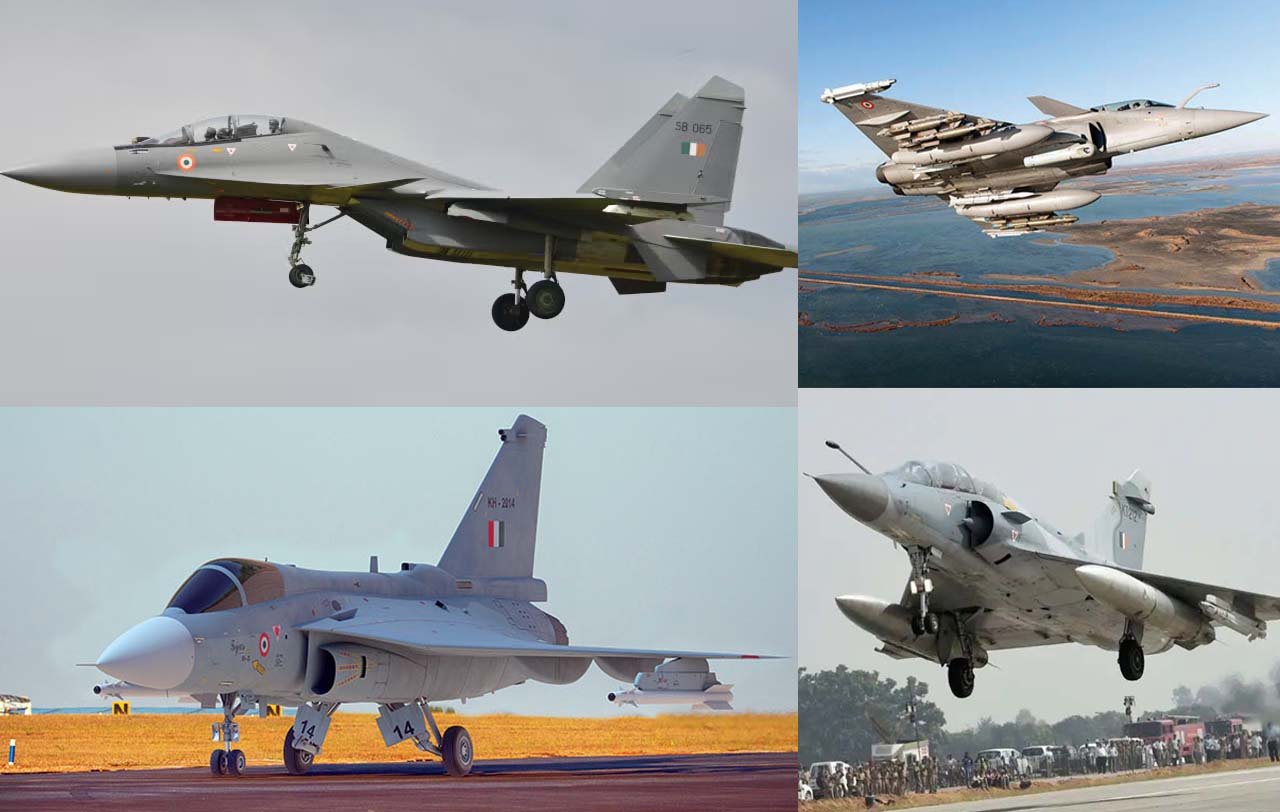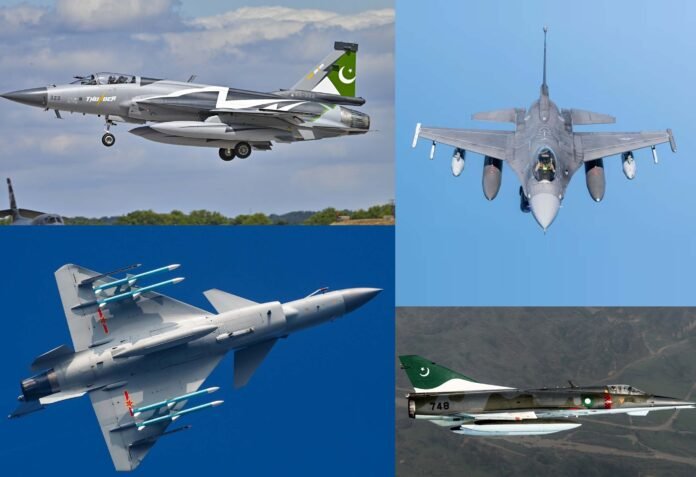Air power remains a critical determinant of military balance between India and Pakistan. As of 2025, the Pakistan Air Force (PAF) faces significant challenges in maintaining a modern, capable fighter fleet amid economic constraints, international sanctions and aging aircraft. This situation contrasts sharply with the Indian Air Force (IAF), which, despite its own squadron shortages, continues to bolster its inventory through indigenous production and strategic acquisitions. The PAF’s vulnerabilities, which were exposed during Operation Sindoor, could present India with opportunities to enhance its deterrence, diplomatic leverage and regional influence — provided these are pursued through measured means.
The State of Pakistan’s Air Force: Numbers and Capabilities
The PAF’s active inventory stands at approximately 879 aircraft, with fighters comprising about 57 percent of its strength. However, a closer examination reveals a fleet heavily reliant on outdated platforms, limiting its effectiveness in modern aerial warfare. The core consists of three main multirole fighters: the JF-17 Thunder, F-16 Fighting Falcon and J-10C.
JF-17 Thunder: Co-developed with China, this forms the backbone with around 149 units in service, including 47 Block 1, 62 Block 2 and 25 Block 2B variants. The newer Block 3 (approximately 30 units) features China’s KLJ-7A air-cooled AESA radar, offering beyond-visual-range (BVR) capabilities, but earlier blocks use mechanically scanned radars with shorter detection ranges and inferior performance against stealth threats. Production capacity allows for 20 Block 3 aircraft annually, enabling gradual replacement of older jets.
F-16 Fighting Falcon: Around 75 aircraft, mostly older Block 15/MLU variants. These are US-supplied aircraft designed in the 1970s. No major upgrades have been reported recently, and acquisitions are hampered by Pakistan’s comatose economy.
J-10C: Roughly 20-25 units, representing the PAF’s most advanced platform with AESA radar and modern BVR missiles like the PL-15. Deliveries began in 2022, but the fleet remains small compared to India’s equivalents.
Beyond these, the PAF operates ageing fleets: over 80 Mirage III variants (upgraded under Project ROSE for ground attack) and around 90 Mirage 5s, neither fully capable of BVR combat. The Chengdu F-7PG (about 140 units) serves primarily as interceptors and trainers, with the F-7P variant phased out. These older aircraft are relegated to secondary roles, exacerbating the PAF’s shortage of cutting-edge fighters — fewer than 50 equipped with AESA radars and advanced avionics.
Recent developments highlight ongoing modernisation efforts, such as the delivery of JF-17 Block III to Azerbaijan (though some reports note these as part of joint exercises rather than sales). Pakistan has also expressed interest in acquiring 40-60 J-35 fifth-generation stealth fighters from China, announced in 2024. However, economic woes, including a strained defence budget and reliance on Chinese loans, have slowed progress. No major retirements were noted in 2025, but the phasing out of F-7Ps underscores a shift toward fewer, more capable platforms amid resource limitations.
The PAF’s active inventory stands at approximately 879 aircraft, with fighters comprising about 57 percent of its strength. However, a closer examination reveals a fleet heavily reliant on outdated platforms, limiting its effectiveness in modern aerial warfare
A Comparative Edge
In contrast, the IAF’s inventory totals around 1,716 aircraft, with a focus on multirole fighters that provide superior numerical and technological advantages. Key platforms include:
Sukhoi Su-30MKI: 260 units, license-built by Hindustan Aeronautics Limited (HAL), offering advanced air superiority and strike capabilities with thrust-vectoring engines. India has the capacity to crank up production if needed.
Dassault Rafale: 36 multirole fighters, inducted since 2022, with AESA radars and long-range Meteor missiles for BVR dominance. India is also pursuing a government-to-government deal for 114 more.
HAL Tejas: Around 40 in service (Mark 1), with 123 more ordered (including Mark 1A); indigenous production ramps up to address squadron shortfalls. Since the IAF has never tested them in combat, the PAF’s current state of weakness is the ideal opportunity for this rookie aircraft to draw first blood.
Mikoyan MiG-29UPG: 69 upgraded units for air superiority.
Dassault Mirage 2000: 49 units, undergoing upgrades to MK2 standard.
SEPECAT Jaguar: 139 ground-attack aircraft, with DARIN-3 upgrades extending service life until 2030.
The IAF operates 31 combat squadrons (down from 41 in 1996 due to retirements like MiG-21s), aiming for 42 by inducting more Tejas and potentially foreign jets. Comparisons show India’s edge: superior numbers (1,399 total aircraft vs Pakistan’s 1,200), advanced platforms like the Su-30MKI and Rafale, and better integration of electronic warfare systems.
While Pakistan claims skilled pilots and agile tactics, India’s larger fleet and ongoing modernisation (such as the fifth-generation AMCA development) provide overwhelming air dominance potential.
Operation Sindoor in 2025 underscored these disparities, with India downing five Pakistani jets, while Pakistan countered with claims against six Indian aircraft, including a Rafale. However, independent analysts agree with India’s claims due to the overwhelming amount of evidence presented by the IAF. In comparison, the primary ‘evidence’ provided by the Pakistanis was their Defence Minister’s laughable statement: “It is all on social media, on Indian social media, not ours.”
Reasons behind Pakistan’s Depletion
Pakistan’s air force challenges stem from multiple factors. Economic pressures — exacerbated by floods and debt — divert funds from defence, forcing reliance on cheaper Chinese options like the JF-17 and J-10C. Border tensions with Afghanistan, including airstrikes against Taliban targets in 2025, further stretch resources. Meanwhile, domestic crises like floods have repurposed PAF assets for humanitarian aid, delaying combat readiness.
Opportunities for India
The PAF’s structural decay — fewer than 70 modern fighters, with serviceability hovering at 40-50 percent due to Chinese supply chain bottlenecks — creates an asymmetry that the IAF can exploit through persistent forward presence, integrated surveillance, and calibrated exercises. This isn’t about provocation; it’s about normalising Indian air dominance in contested zones, forcing Pakistan into a reactive, resource-draining posture.
Recent developments highlight ongoing modernisation efforts, such as the delivery of JF-17 Block III to Azerbaijan (though some reports note these as part of joint exercises rather than sales). Pakistan has also expressed interest in acquiring 40-60 J-35 fifth-generation stealth fighters from China, announced in 2024. However, economic woes, including a strained defence budget and reliance on Chinese loans, have slowed progress
PEACETIME BOXING-IN: SUSTAINED PRESSURE WITHOUT FIRING A SHOT
- Permanent Forward Posture
- Deployment: Rotate 4-5 squadrons (80-100 aircraft) of Rafale + Su-30MKI to forward bases year-round:
- Northern Sector: Udhampur + Avantipur (covers LoC, Siachen, Gilgit-Baltistan).
- Western Sector: Bhuj + Jodhpur (covers Sindh, southern Punjab).
- Gulf of Kutch Flank: Naliya (maritime denial over Arabian Sea approaches).
- Integration Layer:
- S-400 at 3-4 sites (Adampur, Bhuj) creates overlapping 400 km bubbles.
- 3-4 Netra + Phalcon AWACS on 24/7 CAP orbits, linked via IACCS.
- DRDO GWLR-400 + Arudhra radars for low-level penetration detection.
Outcome in Peace: PAF cannot fly routine combat air patrol (CAP) west of the Lahore-Islamabad line without entering Indian sensor envelopes. Any PAF sortie triggers an IAF scramble, forcing Pakistan to either:
- Stand down (cede air initiative) or
- Burn scarce airframes/fuel on defensive scrambles (accelerates fleet decay).
- Exercise Calendar as Psychological Warfare
- Monthly “Gagan Shakti”-style drills in forward areas with live BVR shots (Meteor, R-77).
- Invite ASEAN/US/France observers → signals coalition backing.
- Simulate PAF profiles: Use IAF Jaguars as “red air” mimicking JF-17 radar signatures.
- Outcome: PAF forced to mirror exercises → drains spares budget. Pakistan’s political cost: admitting inability to respond risks domestic backlash.
- Drone and Missile Shadow Boxing
- Deploy Heron Mk-II + TAPAS MALE drones on persistent LoC orbits (200+ km endurance).
- Arm with SMART anti-radiation missiles → passive PAF radar mapping.
- BRAHMOS-NG batteries in forward silos (300 km range) → implicit threat to PAF bases (Sargodha, Kamra).
- Outcome: PAF must keep SAMs (HQ-9) active 24/7 → electronic emissions give IAF daily SIGINT fixes.
WARTIME BOXING-IN: COMPRESSING PAF INTO A 48-HOUR KILL BOX
In war, the IAF’s goal isn’t air superiority — it’s air paralysis. With PAF’s (less than) 35 BVR-capable fighters at 50 percent readiness, India can achieve this in 48-72 hours via layered suppression.

Phase 0 (Pre-Hostilities)
- Stand-off SEAD (suppression of enemy air defences): Brahmos-A from Su-30s targets PAF radar sites (150-200 km inside Pakistan).
- Drone Swarms: 100+ Harop/Harpy loitering munitions saturate HQ-9 batteries.
Phase 1 (0–24 Hours): Collapse the Sensor Grid
- AWACS + S-400 Kill Chain:
- Phalcon detects PAF takeoff at 300+ km.
- S-400 engages at 250 km with 48N6E3 (Mach 14).
- Rafale CAPs (Meteor, 150 km) pick off leakers.
The PAF’s structural decay — fewer than 70 modern fighters, with serviceability hovering at 40-50 percent due to Chinese supply chain bottlenecks — creates an asymmetry that the IAF can exploit through persistent forward presence, integrated surveillance, and calibrated exercises
Target Set:
- 4 main PAF bases (Sargodha, Kamra, Peshawar, Jacobabad).
- 6 forward operating bases (FOBs) neutralised by Prachand attack helicopters armed with Helina air-to-surface missiles to take out anti-tank and other ground targets.
- PAF Math: Even if 50 aircraft scramble, they face considerable numerical odds against the IAF’s frontline Rafale-led fleet. Plus, it faces a 5:1 sensor disadvantage. The upshot → 80 percent attrition in the first 12 hours.
Phase 2 (24–48 Hours): Deny Regeneration
- Runway Cratering: Sudarshan LGBs + Spice-2000 from Mirage 2000s.
- Logistics Strangulation:
- Target Kamra (JF-17 assembly) with Scalp cruise missiles.
- Sink Chinese resupply ships at Gwadar with BrahMos (naval variant).
- PAF C2 (command and control) decapitation: ELINT pods on Su-30s jam Link-17 datalinks.
Phase 3 (48+ Hours): Airspace Sterilization
- IAF shifts to deep strike packages (Rafales and Jaguars escorted by Su-30) hitting:
- Nuclear storage sites (if escalation ladder climbs).
- CPEC nodes (economic coercion).
- PAF effectively grounded.
Strategic Payoff
Nuclear Threshold: No Indian boots cross the border; PAF’s “first strike” option (via the 350-600 km Ra’ad cruise missile) is neutered without the need for an Indian nuclear response.
Pakistan’s Dilemma: Escalate to missiles (Nasr) → risks Indian counter-value strikes. Or concede air corridor → enables the Indian Army’s Cold Start pivots.
Long-Term: PAF’s rebuild cost (more than $15 billion for 100 5th-gen fighters) is unaffordable with $400 billion GDP and 70 percent debt-to-GDP. India locks in a decade of air hegemony at less than 5% of the IAF’s budget.
The IAF doesn’t need to destroy the PAF — it just needs to out-exist it.
–The writer is a globally cited defence analyst based in New Zealand. The views expressed are of the writer and do not necessarily reflect the views of Raksha Anirveda






